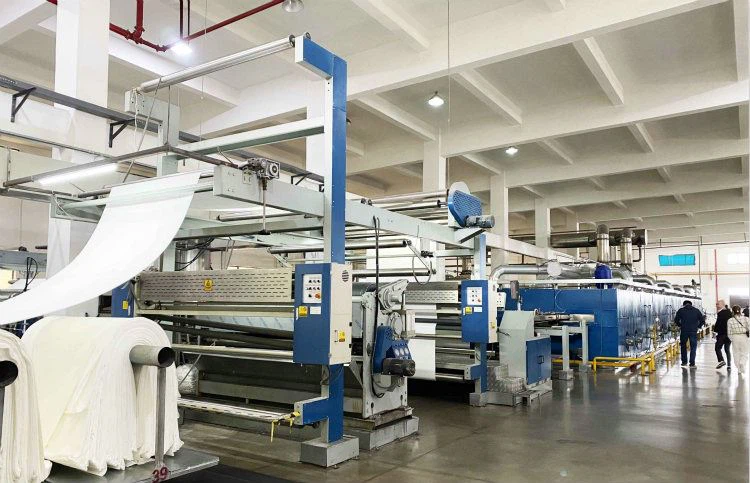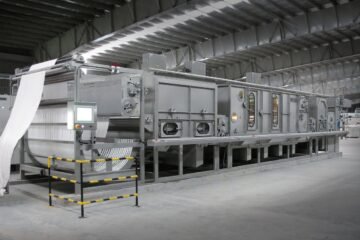Heat Setting:
Heat setting is a critical process for fabrics made from synthetic fibers like polyester (PE), polyamide (PA), and elastomers, as well as triacetate and some polyacrylonitrile (PAC) fibers. It enhances dimensional stability and provides excellent crease resistance, which lasts until the fabric is exposed to temperatures higher than those used in the heat setting process (such as during air exposure). This treatment, typically performed on gray, scoured, or dyed fabrics, ensures the fabric maintains its shape and reduces wrinkling. It works by heating the fabric to temperatures above the second-order glass transition point (around 80-85°C for acrylics), stabilizing its structure.
The heat setting process must be conducted in carefully controlled temperature and moisture conditions to achieve optimal results. If the temperature fluctuates inside the stenter machine, the fiber’s crystallinity can vary, leading to uneven dye absorption. This affects the fabric’s hand feel, and inconsistent moisture levels can cause defects. Low temperatures may result in inadequate setting, while excessive heat or prolonged exposure can cause issues such as yellowing in PA and elastomeric fibers, a stiff texture in acrylics, or loss of elasticity in stretch fabrics.
In addition, the presence of combustion gases (like nitrogen oxides) can lead to yellowing in elastomeric fibers. Heat setting before scouring can lock in stains, making them harder to remove, while performing it after dyeing can risk dye sublimation if not handled with care.
Decortication (for Polyester):
Decortication is a process designed to give polyester fabrics a smooth, silky hand feel, a lustrous appearance, and better drapability. Historically, it was also used to create microfilaments by refining the fiber’s fineness. This process works best with fabrics made from coarser yarns.
Decortication can be done either in open-width or rope form. Open-width decortication is typically carried out on jiggers or beam dyeing machines, while rope decortication is performed in jet or overflow systems. The fabric undergoes decortication after both scouring and heat setting, with a second heat setting treatment recommended afterward.
The process is done at temperatures ranging from 90-130°C for about 20-35 minutes, using a sodium hydroxide solution (30-50 g/L NaOH). Afterward, the fabric is thoroughly washed and neutralized to prevent damage.
Elastic Fabrics:
For fabrics containing elastic fibers, especially segmented polyurethane, specialized treatments are required to maintain their stretch properties. These treatments generally follow this order: relaxation, heat setting, scouring, bleaching or dyeing, and finishing.
Relaxation: Before any major treatment, it’s important to relax woven or knitted fabrics to ensure uniform shrinkage and prevent distortion, creases, or wrinkles. Relaxation techniques may include table steaming, steaming at the stenter entry, hot solvent scouring, or tensionless scouring in hot water.
Heat Setting: This step is crucial for ensuring dimensional stability in elastic fabrics. To achieve optimal results, the fabric should be heat set at 180-200°C for at least 45 minutes. It’s recommended to use an indirect-air heating stenter to avoid fiber yellowing from gas exposure. Since fabrics shrink during heat setting, they should be slightly wider on the stenter to compensate for this shrinkage (usually 5-10% wider than the final desired width). Excessive heat setting may cause discoloration, while insufficient heat setting can lead to poor fabric stability.
Scouring: The scouring process must be carefully tailored to the properties of the fibers used in conjunction with polyurethane elastomers.
Bleaching: When bleaching elastic fabrics, sodium hydrosulfite is often used, and an optical brightening agent can be added for enhanced whiteness.







